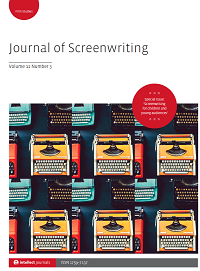- Home
- A-Z Publications
- Journal of Screenwriting
- Previous Issues
- Volume 4, Issue 2, 2013
Journal of Screenwriting - Volume 4, Issue 2, 2013
Volume 4, Issue 2, 2013
-
-
writing with light: The screenplay and photography
More LessThis article considers alternative processes for recording the screen idea, specifically, processes that draw on photography and images in the writing process. It discusses screen works inspired by the photographs of Samuel Bollendorff (Journey to the End of Coal, 2009), Arthur Felig Weegee (The Naked City, 2002) and August Sanders (Do Right and Fear No-one, 1975), and proposes that ‘writing with light’ is an appropriate metaphor for screenplays that are inherently unstable and always in transition.
-
-
-
Tracing the voice of the auteur: Persona and the Ingmar Bergman Archive
More LessThis article discusses the Ingmar Bergman Archive, a donation by Bergman himself, mainly consisting of notebooks, manuscripts, production documents and letters, as well as the screenwriting process behind the film Persona (1966). The study approaches the digital manuscript archive as an interface that lends itself to an understanding of the artwork as continuous movement of transformation across media, an understanding that also links to aesthetical ideas on the relations between words and images expressed in Bergman’s cinematographic work. The study opens with a discussion of these issues and continues with a reading of the self-reflexive film Persona in order to examine how the explicit reflections on the mediation are negotiated across notebook drafts and scripts. The different phases in the process of creation – from notes and drafts to script versions and film – reflect on the transitory nature of the text as well as drawing on the specificities of each form of expression.
-
-
-
Unknown spaces and uncertainty in film development
More LessBy Margot NashThis article examines a discovery-driven process to script development as opposed to a formula-driven one. It is an investigation into the uncertain nature of the creative process in general, and the all-pervasive quest for certainty in film development in particular. Development strategies that value a discovery-driven process are few and far between, as are strategies to explore the gaps, or elisions, within a screenplay where subtext thrives, yet these are transformative spaces that invite an active and creative response. In this article I engage in practice-based research as a writer/director and as a teacher, and investigate two particular areas of film development. The first is early-stage script development where ideas are still struggling to find form; the second is latter-stage script development where a screenplay is refined in order to create spaces where others might respond imaginatively. I advocate risk taking, and the use of unconventional models, in order to create new spaces for students to explore their creativity, and I examine the ‘unknown’ and the ‘uncertain’ as active spaces, both for a screenwriter developing new work and for those who engage creatively with a screenplay as it transforms into a film. I argue that gaps or spaces within a screenplay offer opportunities for directors, actors, key creative crew and eventually an audience to actively participate, and that a development process that values the unknown offers the screenwriter a gateway to adventure and innovation. Screenwriting textbooks rarely enter the unknown and uncertain spaces of creativity yet, as many artists (albeit working in less-expensive mediums) seem to know instinctively, it is within the interplay of the known and the unknown, of passion and reason, and of logic and intuition – that creativity lies.
-
-
-
Don’t Look Now: The screenwork as palimpsest
More LessThe development of the screen idea is a dynamic, interactive process, involving a range of documents and collaborators. This article will consider the extra layer that adaptation from prose fiction to script adds to this process. Taking as my example the short story by Daphne du Maurier, Don’t Look Now, adapted for the screen by Allan Scott and Chris Bryant and subsequently directed by Nicolas Roeg (1973), I will focus in particular on the adaptation of narrative voice, from short story to screen: examining narration strategies in the short story, screenplay drafts and film, and the relationship between them. My discussion will explore the relevance of Ferrer and Groden’s notion of the creative process as an ‘always virtually present’ background process, of which each element of text and avant-texte constitutes but one manifestation. It will also introduce the figure of the palimpsest, considering how it might illuminate an understanding of the screenwork as constructed through the various layers that have contributed to its genesis, producing a multiple rather than a singular entity.
-
-
-
Screenwriter Rafael Azcona, writing of his times
More LessThe aim of this article is to introduce the screenwriter Rafael Azcona, a key figure in the development of Spanish cinema, to an international audience. And rather than analyse his screenwriting work as simply a writer, I wish to look on his work as a spatial screenwriter, a creator of unforgettable images, situations and places in which his stories play out and his characters become unique. The concept of ‘space’ in his work is in reference to the relationship between the character and what André Gardies has referred to as ‘the cinematic narrative in relation to space’ or ‘narrative space’.
-
-
-
REVIEWS
More LessAuthors: Oliver Harris, James Newton and Jule SelboSCRIPTING HITCHCOCK: PSYCHO, THE BIRDS, AND MARNIE, WALTER RAUBICHECK AND WALTER SREBNIK (2011) Urbana: University of Illinois Press, 131 pp., ISBN 978-0-252-07824-8, p/bk, £14.99
CHARLIE KAUFMAN: CONFESSIONS OF AN ORIGINAL MIND, DOREEN ALEXANDER CHILD (2010) Santa Barbara, Ca: Praeger, 208pp., ISBN: 978-0313358609, p/bk, £30.35
FUNNY, THE BOOK: EVERYTHING YOU ALWAYS WANTED TO KNOW ABOUT COMEDY, DAVID MISCH (2012) Wisconsin: Hal Leonard Publishing, 173 pp., ISBN: 978-1-55783-829-2, p/bk, $18.99
-
Most Read This Month


